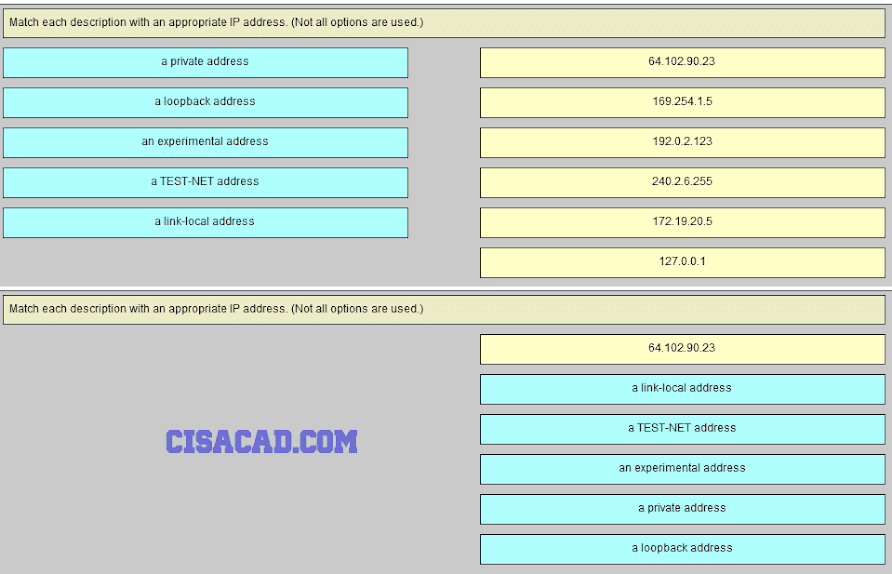1. How many bits are in an IPv4 address?
32*
64
128
256
2. Which two parts are components of an IPv4 address? (Choose two.)
subnet portion
network portion*
logical portion
host portion*
physical portion
broadcast portion
3. What is the prefix length notation for the subnet mask 255.255.255.224?
/25
/26
/27*
/28
4. A message is sent to all hosts on a remote network. Which type of message is it?
limited broadcast
multicast
directed broadcast*
unicast
5. What two statements describe characteristics of Layer 3 broadcasts? (Choose two.)
Broadcasts are a threat and users must avoid using protocols that implement them.
Routers create broadcast domains.*
Some IPv6 protocols use broadcasts.*
There is a broadcast domain on each switch interface.
A limited broadcast packet has a destination IP address of 255.255.255.255.
A router will not forward any type of Layer 3 broadcast packet.*
6. A DHCP server is used to assign IP addresses dynamically to the hosts on a network. The address pool is configured with 192.168.10.0/24. There are 3 printers on this network that need to use reserved static IP addresses from the pool. How many IP addresses in the pool are left to be assigned to other hosts?
254
251*
252
253
7. Which network migration technique encapsulates IPv6 packets inside IPv4 packets to carry them over IPv4 network infrastructures?
encapsulation
translation
dual-stack
tunneling*
8. Which two statements are correct about IPv4 and IPv6 addresses? (Choose two.)
IPv6 addresses are represented by hexadecimal numbers.*
IPv4 addresses are represented by hexadecimal numbers.
IPv6 addresses are 32 bits in length.
IPv4 addresses are 32 bits in length.*
IPv4 addresses are 128 bits in length.
IPv6 addresses are 64 bits in length.
9. Which IPv6 address is most compressed for the full FE80:0:0:0:2AA:FF:FE9A:4CA3 address?
FE8::2AA:FF:FE9A:4CA3?
FE80::2AA:FF:FE9A:4CA3*
FE80::0:2AA:FF:FE9A:4CA3?
FE80:::0:2AA:FF:FE9A:4CA3?
10. What are two types of IPv6 unicast addresses? (Choose two.)
multicast
loopback*
link-local*
anycast
broadcast
11. What are three parts of an IPv6 global unicast address? (Choose three.)
an interface ID that is used to identify the local network for a particular host
a global routing prefix that is used to identify the network portion of the address that has been provided by an ISP*
a subnet ID that is used to identify networks inside of the local enterprise site*
a global routing prefix that is used to identify the portion of the network address provided by a local administrator
an interface ID that is used to identify the local host on the network*
12. An IPv6 enabled device sends a data packet with the destination address of FF02::1. What is the target of this packet?
all IPv6 DHCP servers
all IPv6 enabled nodes on the local link*
all IPv6 configured routers on the local link
all IPv6 configured routers across the network
13. When a Cisco router is being moved from an IPv4 network to a complete IPv6 environment, which series of commands would correctly enable IPv6 forwarding and interface addressing?
Router# configure terminal
Router(config)# interface fastethernet 0/0
Router(config-if)# ip address 192.168.1.254 255.255.255.0
Router(config-if)# no shutdown
Router(config-if)# exit
Router(config)# ipv6 unicast-routing
Router# configure terminal
Router(config)# interface fastethernet 0/0
Router(config-if)# ipv6 address 2001:db8:bced:1::9/64
Router(config-if)# no shutdown
Router(config-if)# exit
Router(config)# ipv6 unicast-routing***
Router# configure terminal
Router(config)# interface fastethernet 0/0
Router(config-if)# ipv6 address 2001:db8:bced:1::9/64
Router(config-if)# no shutdown
Router# configure terminal
Router(config)# interface fastethernet 0/0
Router(config-if)# ip address 2001:db8:bced:1::9/64
Router(config-if)# ip address 192.168.1.254 255.255.255.0
Router(config-if)# no shutdown
14. Which two ICMP messages are used by both IPv4 and IPv6 protocols? (Choose two.)?
router solicitation
route redirection*
neighbor solicitation
protocol unreachable*
router advertisement
15. When an IPv6 enabled host needs to discover the MAC address of an intended IPv6 destination, which destination address is used by the source host in the NS message?
all-node multicast address
solicited-node multicast address*
link-local address of the receiver
global unicast address of the receiver
16. When will a router drop a traceroute packet?
when the router receives an ICMP Time Exceeded message
when the RTT value reaches zero
when the host responds with an ICMP Echo Reply message
when the value in the TTL field reaches zero*
when the values of both the Echo Request and Echo Reply messages reach zero
17. What is indicated by a successful ping to the ::1 IPv6 address?
The host is cabled properly.
The default gateway address is correctly configured.
All hosts on the local link are available.
The link-local address is correctly configured.
IP is properly installed on the host.*
18. Which two things can be determined by using the ping command? (Choose two.)
the number of routers between the source and destination device
the IP address of the router nearest the destination device
the average time it takes a packet to reach the destination and for the response to return to the source*
whether or not the destination device is reachable through the network*
the average time it takes each router in the path between source and destination to respond
19. Fill in the blank.
The decimal equivalent of the binary number 10010101 is 149 .
20. Fill in the blank.
What is the decimal equivalent of the hex number 0x3F? 63
21. Match each description with an appropriate IP Address. (Not all options are used.)

169.254.1.5 -> a link-local address
192.0.2.153 -> a TEST-NET address
240.2.6.255 -> an experimental address
172.19.20.5 -> a private address
127.0.0.1 -> a loopback address
22. Match each description with an appropriate IP address. (Not all options are used.)

192.31.18.123 -> a legacy class C address
198.256.2.6 -> an invalid IPv4 address
64.100.3.5 -> a legacy class A address
224.2.6.255 -> a legacy class D address
128.107.5.1 -> a legacy class B address
23. Open the PT Activity.
Perform the tasks in the activity instructions and then answer the question.
Which message is displayed on the web server?
You did it right!
Correct configuration!
IPv6 address configured!
Successful configuration!



